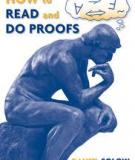Tài liệu Thư viện số
- Sư phạm mầm non (303 )
- Dược (328 )
- Y - Y sỹ (538 )
- Điều dưỡng (274 )
- Thú y (304 )
- Công nghệ thông tin (520 )
- Kỹ thuật (395 )
- Kinh tế (551 )
- Du lịch (323 )
- Ngoại ngữ (309 )
- Môn cơ bản (294 )
- Tài liệu tham khảo khác (227 )
Danh mục TaiLieu.VN
- Mẫu Slide Powerpoint
- Luận Văn - Báo Cáo (344720)
- Kinh Doanh Marketing (65512)
- Kinh Tế - Quản Lý (48934)
- Tài Chính - Ngân Hàng (55898)
- Công Nghệ Thông Tin (142209)
- Tiếng Anh - Ngoại Ngữ (47066)
- Kỹ Thuật - Công Nghệ (134345)
- Khoa Học Tự Nhiên (107174)
- Khoa Học Xã Hội (82451)
- Văn Hoá - Nghệ Thuật (54408)
- Y Tế - Sức Khoẻ (173915)
- Nông - Lâm - Ngư (62504)
- Kỹ Năng Mềm (29016)
- Biểu Mẫu - Văn Bản (27610)
- Giải Trí - Thư Giãn (51994)
- Văn Bản Luật (198854)
- Tài Liệu Phổ Thông (402015)
- Trắc Nghiệm Online (213578)
- Trắc Nghiệm MBTI
- Trắc Nghiệm Holland
Web Solutions for How to Read and Do Proofs
The forward process makes use of the information contained in the
hypothesis A. The backward process tries to find a chain of statements leading
to the fact that the conclusion B is true.
With the backward process, you start with the statement B that you are
trying to conclude is true. By asking and answering key questions, you derive
a sequence of new statements with the property that if the sequence of new
statements is true, then B is true. The backward process continues until you
obtain the statement A or until you can no longer ask and/or answer the key
question.
With the forward process, you begin with the statement A that you assume
is true. You then derive from A a sequence of new statements that are true
as a result of A being true. Every new statement derived from A is directed
toward linking up with the last statement obtained in the backward process.
The last statement of the backward process acts as the guiding light in the
forward process, just as the last statement in the forward process helps you
choose the right key question and answer.
hypothesis A. The backward process tries to find a chain of statements leading
to the fact that the conclusion B is true.
With the backward process, you start with the statement B that you are
trying to conclude is true. By asking and answering key questions, you derive
a sequence of new statements with the property that if the sequence of new
statements is true, then B is true. The backward process continues until you
obtain the statement A or until you can no longer ask and/or answer the key
question.
With the forward process, you begin with the statement A that you assume
is true. You then derive from A a sequence of new statements that are true
as a result of A being true. Every new statement derived from A is directed
toward linking up with the last statement obtained in the backward process.
The last statement of the backward process acts as the guiding light in the
forward process, just as the last statement in the forward process helps you
choose the right key question and answer.
Từ khóa: : Semantic Web, XML, Web Services, Framework, Securing Web Services, ebXML Registries
58 p tailieu_aulac 14/12/2012 365 1


